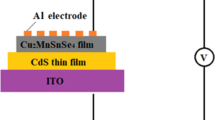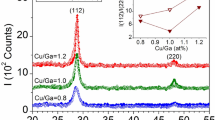Abstract
Heterojunctions, such as ZnO/CdS/CuGaSe2, were fabricated for photovoltaic applications. Optimization of device structures based on monocrystalline CuGaSe2 led to the highest-to-date power conversion efficiencies for CuGaSe2 solar cells. At room temperature under 100 mW/cm2 AM1.5 illumination a maximum cell efficiency of 9.7% was achieved, given by an open-circuit voltage of 946 mV, a short circuit current density of 15.5 mA/cm2, and a fill factor of 66.5%. Preparation and performance of the optimum device are described. Current voltage characteristics dependent on illumination intensity and temperature, spectral response and electron-beam-induced current measurements were performed to determine the device parameters as well as to analyse the current transport and loss mechanisms. Tunneling, assisted by defect levels in the CdS layer, seems to play a major role. High injection effects are observed at forward bias ofV > 0.5 V or an illumination level ofP > 10 mW/cm2. Under such conditions, as well as at low temperatures, the non-zero series resistance comes into play. Effects of the shunt resistance, however, are negligible in all cases.
Similar content being viewed by others
References
J. Stankiewicz, W. Giriat: Appl. Phys. Lett.35, 70 (1979)
N. Romeo, G. Sberveglieri, L. Tarricone, C. Paorici: Appl. Phys. Lett.30, 108 (1977)
W. Simon: Konstanzer Dissertationen 424, Hartung-Gorre Verlag, Konstanz, ISBN 3-89191-789-9 (1994)
M. Saad, W. Simon, K. Friemelt, H. Riazi-Nejad, E. Bucher, M. Ch. Lux-Steiner: InProc. 12th European Conf. PVSEC, Amsterdam, The Netherlands (1994) p. 1546
M. Saad, H. Riazi-Nejad, E. Bucher, M. Ch. Lux-Steiner: InProc. 1st World Conf. on PVEC, Hawaii, USA (1994) p. 412
K.T.R. Reddy, P.J. Reddy: Mater. Lett.10, 275 (1990)
M. Mehlin, J. Rimmasch, H.P. Fritz: Z. Naturforsch.49b, 1597 (1994)
W. Arndt, H. Dittrich, F. Pfisterer, H.W. Schock: InProc. 6th PVSEC (Kluwer, Dordrecht 1985) p. 260
B. Dimmler, H. Dittrich, R. Menner, H.W. Schock: InProc. 19th IEEE PVSEC (IEEE, New York 1987) p. 1454
K.T.R. Reddy, P.J. Reddy: Thin Solid Films253, 238 (1994)
R. Klenk, R. Mauch, R. Schäffler, D. Schmid, H.W. Schock:In Proc. 22nd IEEE PVSEC (IEEE, New York 1991) p. 1071
C.H. Henry: J. Appl. Phys.51, 4494 (1980)
M. Ch. Lux-Steiner: Synthese, optoelektronische Eigenschaften und Anwendungen neuer Halbleiterkristalle. Habilitation, Universität Konstanz (1991)
D. Lincot, R.O. Borges: J. Electrochem. Soc.139, 1880 (1992)
A.L. Fahrenbruch, R.H. Bube:Fundamentals of Solar Cells (Academic, New York 1983)
S. Kunzelmann, K. Bücher:ISE PV-Charts, Edn. 4 (Fraunhofer-Institute for Solar Energy Systems, Freiburg, Germany 1994)
M. Quintero, C. Rincon, P. Grima: J. Appl. Phys.65, 2739 (1989)
C.J. Wu, D.B. Wittry: J. Appl. Phys.49, 2827 (1978)




